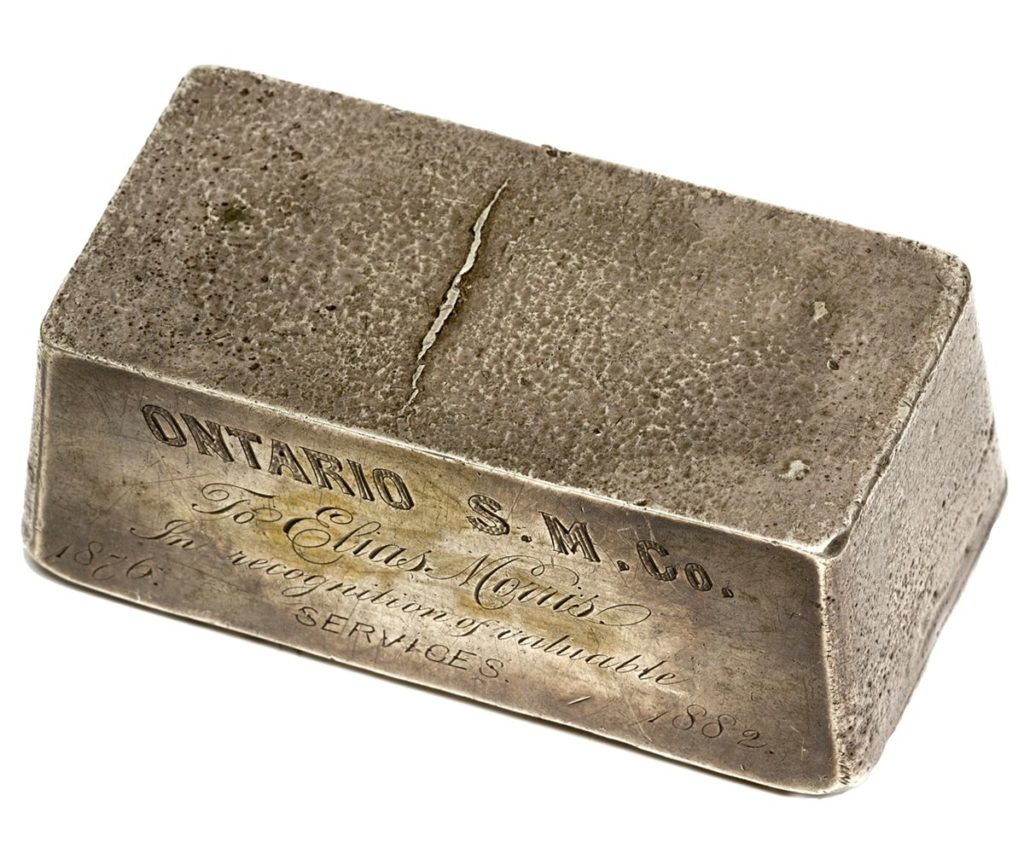20.50 oz UT,Salt Lake City-,Ontario Silver Mining Co. of Park City, Utah, and Elias Morris of Salt Lake City – 1876-1882

This silver ingot measures 3.0” x 1.4” x 1.1” and weighs 20.60 troy oz. It has a highly polished front side on which is engraved: Ontario S. M. Co., To Elias Morris in recognition of valuable services 1876-1882. The trapezoidal ingot is not marked elsewhere. The Ontario Silver mine in Park City was one of the largest silver mines in America outside the Comstock Lode and Leadville.
From 1872 to the present, the mines at Park City produced a whopping 253 million ounces of silver (a bit more than the Comstock), 1.45 million ounces of gold (the Comstock produced about 9 million ounces), 2.3 billion pounds of lead, 1.5 billion pounds of zinc, and 129 million pounds of copper. As the central mine in the district, it was always one of the largest producers. The Ontario mine was located 19 June 1872, and shortly afterwards was sold to George Hearst and partners for $27,000, based on the production reports of silver ores exceeding 200 ounces per ton. During the early years until about 1882, the mine produced ores worth about 100 ounces per ton or more. The average reported during the 1970s was 21 oz/ton [C. Ege; Selected Mining Districts of Utah; digitized, nd)].
Elias Morris was a stone mason in Salt Lake City. He formed a company as early as 1864, and immediately began building stone buildings in Salt Lake in 1864, many of which were in the center of town and among the most important businesses. In 1866 he was called to a Church mission in Wales. Returning in 1870 right after completion of the Central Pacific Railroad, he located a clay mine near Bingham, and began production of fire and other brick. He opened the first marble works in Salt Lake as well, and soon his work was known throughout the territory. He took on a partner, Samuel Evans in 1870, and the pair remained partners until Evans’ death in 1881. In 1876, the Ontario Mine, one of the largest silver mines in America, hired Morris to build a new mill and other buildings needed for a great expansion of the Company’s works. Part of this was the building and installation of a huge Cornish pump in the No. 3 shaft, which was touted as being as large and fine as any on the Comstock. The pump had a thirty foot diameter fly wheel and pumped water at a capacity 2560 gallons per minute. While the pump was “the latest and greatest” at the time, it only took a few years before the pump couldn’t handle the water, and additional pumps had to be installed. Eventually, the underground workings were 2000 feet deep, though the majority of production was above 1500 feet.
In 1880, it was one of only two mines in America outside of the Comstock that paid more than three million in total dividends. The other was the Eureka Consolidated. That year, they produced 1.44 million ounces of silver sold for $1.62 million, up from 1.35 million ounces in 1879. Mine production remained steady for years (See Rothwell, the Mineral Industry, 1892, various pp.). Mining costs at the Ontario were $15.61 per ton prior to 1880, with milling costs at about $17/ton.This ingot is one of only a handful of Utah silver ingots, and is from their most famous silver mine financed by George Hearst.
[12/2012] https://www.icollector.com/Ontario-Silver-Mining-Co-of-Park-City-Utah-and-Elias-Morris-of-Salt-Lake-City-UT-Salt-Lake-Cit_i14654254 ($13,145)
[08/2013] https://www.icollector.com/UT-Salt-Lake-City-Ontario-Silver-Mining-Co-of-Park-City-Utah-and-Elias-Morris-of-Salt-Lake-City_i16987008 ($11,950)
